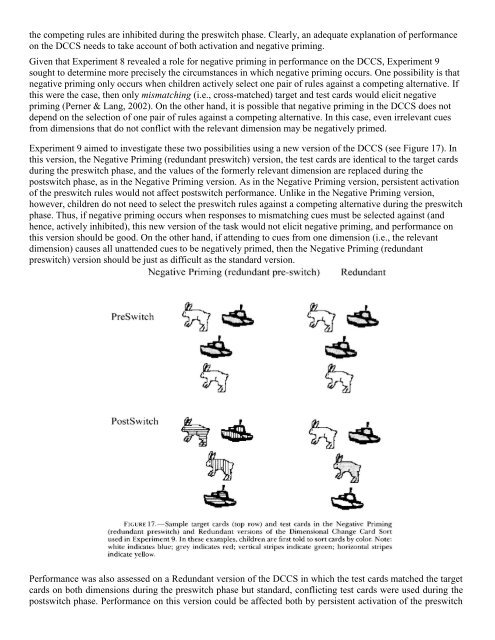THE DEVELOPMENT OF EXECUTIVE FUNCTION IN EARLY ...
THE DEVELOPMENT OF EXECUTIVE FUNCTION IN EARLY ...
THE DEVELOPMENT OF EXECUTIVE FUNCTION IN EARLY ...
You also want an ePaper? Increase the reach of your titles
YUMPU automatically turns print PDFs into web optimized ePapers that Google loves.
the competing rules are inhibited during the preswitch phase. Clearly, an adequate explanation of performance<br />
on the DCCS needs to take account of both activation and negative priming.<br />
Given that Experiment 8 revealed a role for negative priming in performance on the DCCS, Experiment 9<br />
sought to determine more precisely the circumstances in which negative priming occurs. One possibility is that<br />
negative priming only occurs when children actively select one pair of rules against a competing alternative. If<br />
this were the case, then only mismatching (i.e., cross-matched) target and test cards would elicit negative<br />
priming (Perner & Lang, 2002). On the other hand, it is possible that negative priming in the DCCS does not<br />
depend on the selection of one pair of rules against a competing alternative. In this case, even irrelevant cues<br />
from dimensions that do not conflict with the relevant dimension may be negatively primed.<br />
Experiment 9 aimed to investigate these two possibilities using a new version of the DCCS (see Figure 17). In<br />
this version, the Negative Priming (redundant preswitch) version, the test cards are identical to the target cards<br />
during the preswitch phase, and the values of the formerly relevant dimension are replaced during the<br />
postswitch phase, as in the Negative Priming version. As in the Negative Priming version, persistent activation<br />
of the preswitch rules would not affect postswitch performance. Unlike in the Negative Priming version,<br />
however, children do not need to select the preswitch rules against a competing alternative during the preswitch<br />
phase. Thus, if negative priming occurs when responses to mismatching cues must be selected against (and<br />
hence, actively inhibited), this new version of the task would not elicit negative priming, and performance on<br />
this version should be good. On the other hand, if attending to cues from one dimension (i.e., the relevant<br />
dimension) causes all unattended cues to be negatively primed, then the Negative Priming (redundant<br />
preswitch) version should be just as difficult as the standard version.<br />
Performance was also assessed on a Redundant version of the DCCS in which the test cards matched the target<br />
cards on both dimensions during the preswitch phase but standard, conflicting test cards were used during the<br />
postswitch phase. Performance on this version could be affected both by persistent activation of the preswitch
















